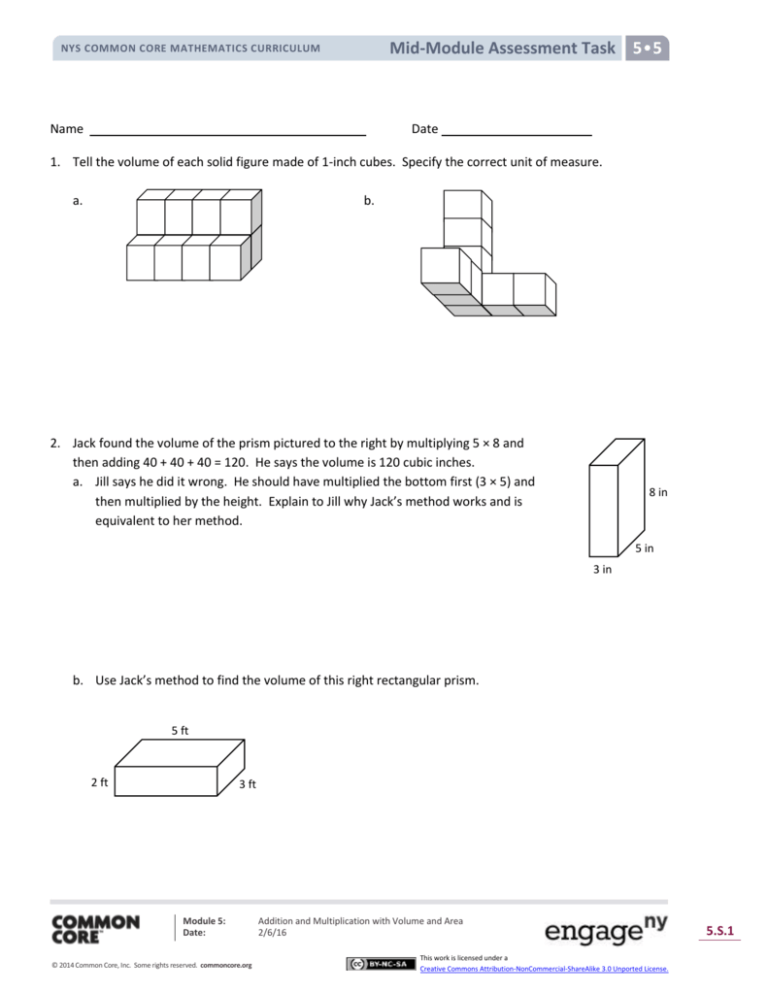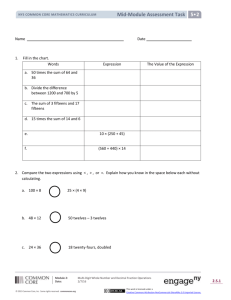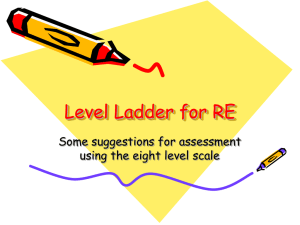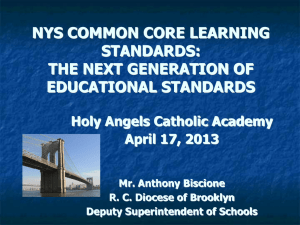
5•5
Mid-Module Assessment Task Lesson
2•3
NYS COMMON CORE MATHEMATICS CURRICULUM
Name
Date
1. Tell the volume of each solid figure made of 1-inch cubes. Specify the correct unit of measure.
a.
b.
2. Jack found the volume of the prism pictured to the right by multiplying 5 × 8 and
then adding 40 + 40 + 40 = 120. He says the volume is 120 cubic inches.
a. Jill says he did it wrong. He should have multiplied the bottom first (3 × 5) and
then multiplied by the height. Explain to Jill why Jack’s method works and is
equivalent to her method.
8 in
5 in
3 in
b. Use Jack’s method to find the volume of this right rectangular prism.
5 ft
2 ft
3 ft
Module 5:
Date:
© 2014 Common Core, Inc. Some rights reserved. commoncore.org
Addition and Multiplication with Volume and Area
2/6/16
This work is licensed under a
Creative Commons Attribution-NonCommercial-ShareAlike 3.0 Unported License.
5.S.1
NYS COMMON CORE MATHEMATICS CURRICULUM
Mid-Module Assessment Task 5•5
2•3
3. If the figure below is made of cubes with 2 cm side lengths, what is its volume? Explain your thinking.
4. The volume of a rectangular prism is 840 in3. If the area of the base is 60 in2, find its height. Draw and
label a model to show your thinking.
5. The following structure is composed of two right rectangular prisms that each measure 12 inches by 10
inches by 5 inches and one right rectangular prism that measures 10 inches by 8 inches by 36 inches.
What is the total volume of the structure? Explain your thinking.
Module 5:
Date:
© 2014 Common Core, Inc. Some rights reserved. commoncore.org
Addition and Multiplication with Volume and Area
2/6/16
This work is licensed under a
Creative Commons Attribution-NonCommercial-ShareAlike 3.0 Unported License.
5.S.2
NYS COMMON CORE MATHEMATICS CURRICULUM
Mid-Module Assessment Task 5•5
2•3
6. a. Find the volume of the rectangular fish tank. Explain your thinking.
45 cm
20 cm
10 cm
b. If the fish tank is completely filled with water, and then 900 cubic centimeters are poured out, how
high will the water be? Give your answer in centimeters, and show your work.
7. Juliet wants to know if the chicken broth in this beaker will fit into this rectangular food storage
container. Explain how you would figure it out without pouring the contents in. If it will fit, how much
more broth could the storage container hold? If it will not fit, how much broth will be left over?
(Remember 1 cm3 = 1 mL.)
4L
15 cm
2L
7 cm
20 cm
Beaker
Module 5:
Date:
© 2014 Common Core, Inc. Some rights reserved. commoncore.org
Storage Container
Addition and Multiplication with Volume and Area
2/6/16
This work is licensed under a
Creative Commons Attribution-NonCommercial-ShareAlike 3.0 Unported License.
5.S.3
NYS COMMON CORE MATHEMATICS CURRICULUM
Mid-Module Assessment Task 5•5
2•3
Mid-Module Assessment Task
Standards Addressed
Topics A–B
Geometric measurement: understand concepts of volume and relate volume to multiplication and to
addition.
5.MD.3
Recognize volume as an attribute of solid figures and understand concepts of volume
measurement.
a.
A cube with side length 1 unit, called a “unit cube,” is said to have “one cubic unit” of
volume, and can be used to measure volume.
b.
A solid figure which can be packed without gaps or overlaps using n unit cubes is said to
have a volume of n cubic units.
5.MD.4
Measure volumes by counting unit cubes, using cubic cm, cubic in, cubic ft, and improvised
units.
5.MD.5
Relate volume to the operations of multiplication and addition and solve real world and
mathematical problems involving volume.
a.
Find the volume of a right rectangular prism with whole-number side lengths by
packing it with unit cubes, and show that the volume is the same as would be found by
multiplying the edge lengths, equivalently by multiplying the height by the area of the
base. Represent threefold whole-number products as volumes, e.g., to represent the
associative property of multiplication.
b.
Apply the formulas V = l × w × h and V = b × h for rectangular prisms to find volumes of
right rectangular prisms with whole-number edge lengths in the context of solving real
world and mathematical problems.
c.
Recognize volume as additive. Find volumes of solid figures composed of two nonoverlapping right rectangular prisms by adding the volumes of the non-overlapping
parts, applying this technique to solve real world problems.
Evaluating Student Learning Outcomes
A Progression Toward Mastery is provided to describe steps that illuminate the gradually increasing
understandings that students develop on their way to proficiency. In this chart, this progress is presented
from left (Step 1) to right (Step 4). The learning goal for students is to achieve Step 4 mastery. These steps
are meant to help teachers and students identify and celebrate what the students CAN do now and what they
need to work on next.
Module 5:
Date:
© 2014 Common Core, Inc. Some rights reserved. commoncore.org
Addition and Multiplication with Volume and Area
2/6/16
This work is licensed under a
Creative Commons Attribution-NonCommercial-ShareAlike 3.0 Unported License.
5.S.4
NYS COMMON CORE MATHEMATICS CURRICULUM
Mid-Module Assessment Task 5•5
2•3
A Progression Toward Mastery
Assessment
Task Item
and
Standards
Assessed
1
5.MD.3
5.MD.4
STEP 1
Little evidence of
reasoning without
a correct answer.
STEP 2
Evidence of some
reasoning without
a correct answer.
STEP 3
Evidence of some
reasoning with a
correct answer or
evidence of solid
reasoning with an
incorrect answer.
STEP 4
Evidence of solid
reasoning with a
correct answer.
(1 Point)
(2 Points)
(3 Points)
(4 Points)
The student has
neither the correct
volume nor the correct
unit of measure for
either figure.
The student calculates
the volume incorrectly
for both figures but
uses the correct unit of
measure.
The student calculates
the volume for one
figure correctly and
uses the correct unit of
measure for both.
The student correctly
calculates the volume
and uses the correct
unit of measure for
both:
a. 12 in3
b. 8 in3
2
5.MD.5a
5.MD.5b
The student is unable
to explain the
equivalence of the two
approaches and is
unable to find the
volume of the prism in
Part (b) using Jack’s
method.
Module 5:
Date:
© 2014 Common Core, Inc. Some rights reserved. commoncore.org
The student makes an
attempt to explain the
equivalence of the two
approaches but uses
faulty logic and is
unable to find the
volume of the prism in
Part (b) using Jack’s
method.
The student explains
the equivalence
between the two
approaches by
explaining that the
sides may be multiplied
in any order because
any face can be used as
the base of the figure
but is unable to use
Jack’s method to
calculate the volume of
the prism in Part (b).
The student may not
score more than 3
points if the student
does not label Part (b)
as cubic feet (ft3).
The student correctly
explains the
equivalence between
the two approaches by
explaining the sides
may be multiplied in
any order because any
face can be used as the
base of the figure. The
student also uses Jack’s
method to correctly
calculate the area of
the prism in Part (b) as
(3 × 2) × 5 = 30 ft3.
Addition and Multiplication with Volume and Area
2/6/16
This work is licensed under a
Creative Commons Attribution-NonCommercial-ShareAlike 3.0 Unported License.
5.S.5
NYS COMMON CORE MATHEMATICS CURRICULUM
Mid-Module Assessment Task 5•5
2•3
A Progression Toward Mastery
3
5.MD.5a
4
5.MD.5
The student is neither
able to calculate the
volume of the figure
nor explain the
reasoning used.
The student uses a
correct method for
finding the volume of
the cube but does not
consider the size of the
cubes (2 cm side
lengths) and does not
explain the reasoning
used.
The student uses a
correct method for
finding the volume of
the cube and is able to
explain the reasoning
used but does not
consider the size of the
cubes (2 cm side
lengths). The student
may not score more
than 3 points if the
student does not
correctly identify the
units as cubic
centimeters (cm3).
The student correctly
answers 1,440 cm3 and
is able to explain the
reasoning used.
The student is neither
able to calculate the
height of the prism nor
able to draw and label
a model.
The student is able to
either find the missing
height or draws an
unlabeled model.
The student draws a
labeled model showing
60 in2, and some inches
high, but makes a
calculation error when
finding the height of
the prism.
The student clearly
does the following:
Draws a threedimensional
rectangular prism as
a model.
Labels the model,
including inches for
height and inches
squared for the
base.
Calculates the height
of the prism as 14 in.
5
5.MD.5c
The student is able to
calculate the volume of
one part of the figure
but is unable to explain
the reasoning used.
Module 5:
Date:
© 2014 Common Core, Inc. Some rights reserved. commoncore.org
The student explains
the reasoning used but
makes more than one
calculation error.
The student explains
the reasoning used but
makes one calculation
error. The student may
not score more than 3
points if the student
does not correctly
identify the units as
cubic inches (in3).
The student does the
following:
Correctly calculates
the volume of the
prism as 4,080 in3.
Clearly explains the
reasoning used.
Addition and Multiplication with Volume and Area
2/6/16
This work is licensed under a
Creative Commons Attribution-NonCommercial-ShareAlike 3.0 Unported License.
5.S.6
NYS COMMON CORE MATHEMATICS CURRICULUM
Mid-Module Assessment Task 5•5
2•3
A Progression Toward Mastery
6
5.MD.5b
7
5.MD.3
The student is unable
to correctly answer any
part of the task.
The student attempts a
calculation but does
not achieve an answer
or explain her thinking.
The student correctly
answers either Part (a)
or Part (b), but does
not explain the
reasoning used.
The student attempts
part of the answer but
miscalculates or does
not explain her
thinking.
The student calculates
either Part (a) or Part
(b) correctly and
explains the reasoning
used. The student may
not score more than 3
points if the student
does not correctly
identify the units as
cubic centimeters
(cm3).
The student correctly
does the following:
The student explains
her thinking and
correctly calculates
either the volume in
the beaker or the
volume of the
container but makes a
mistake in the other,
leading to incorrect
answers.
The student does the
following:
a. Calculates 9,000
cm3 and clearly
explains the
reasoning used.
b. Calculates 18 cm
and shows correct
work and
reasoning.
Clearly explains a
method for
determining if the
contents will fit
without pouring—
2,400 mL = 2,400
cm3.
Correctly answers
that the broth will
not fit.
Correctly answers
that Juliet will have
300 more mL (or 300
cm3), or 0.3 L, of
broth that won’t fit
in the storage
container.
Module 5:
Date:
© 2014 Common Core, Inc. Some rights reserved. commoncore.org
Addition and Multiplication with Volume and Area
2/6/16
This work is licensed under a
Creative Commons Attribution-NonCommercial-ShareAlike 3.0 Unported License.
5.S.7
NYS COMMON CORE MATHEMATICS CURRICULUM
Module 5:
Date:
© 2014 Common Core, Inc. Some rights reserved. commoncore.org
Mid-Module Assessment Task 5•5
2•3
Addition and Multiplication with Volume and Area
2/6/16
This work is licensed under a
Creative Commons Attribution-NonCommercial-ShareAlike 3.0 Unported License.
5.S.8
NYS COMMON CORE MATHEMATICS CURRICULUM
Module 5:
Date:
© 2014 Common Core, Inc. Some rights reserved. commoncore.org
Mid-Module Assessment Task 5•5
2•3
Addition and Multiplication with Volume and Area
2/6/16
This work is licensed under a
Creative Commons Attribution-NonCommercial-ShareAlike 3.0 Unported License.
5.S.9
NYS COMMON CORE MATHEMATICS CURRICULUM
Module 5:
Date:
© 2014 Common Core, Inc. Some rights reserved. commoncore.org
Mid-Module Assessment Task 5•5
2•3
Addition and Multiplication with Volume and Area
2/6/16
This work is licensed under a
Creative Commons Attribution-NonCommercial-ShareAlike 3.0 Unported License.
5.S.10








![Volume of Prisms and Cylinders [12/4/2013]](http://s2.studylib.net/store/data/005712570_1-e7691fc1893418ebe51c7a30e9e35d27-300x300.png)



